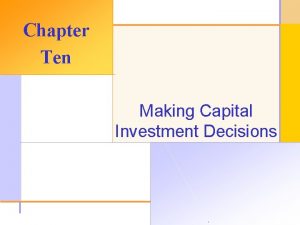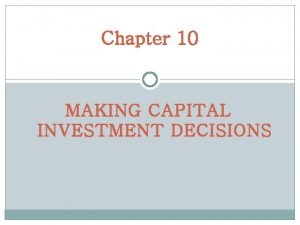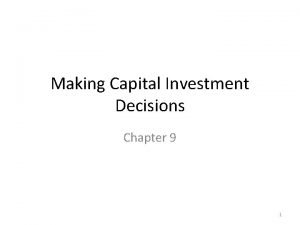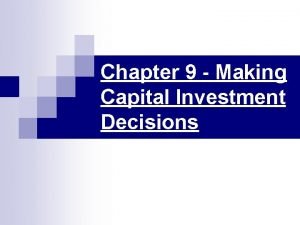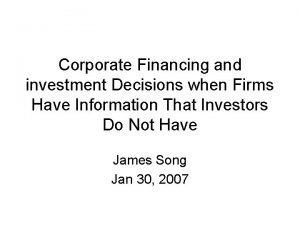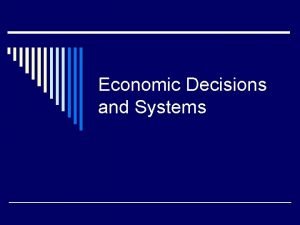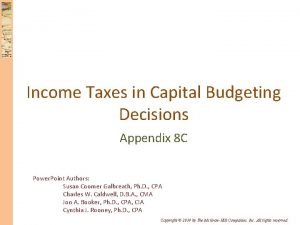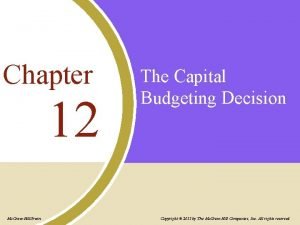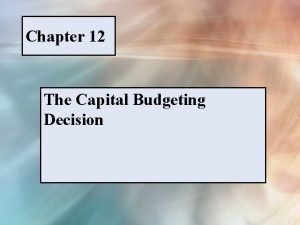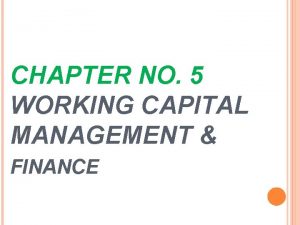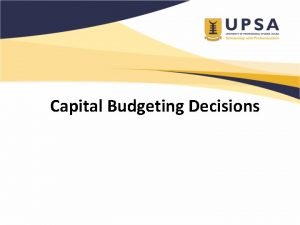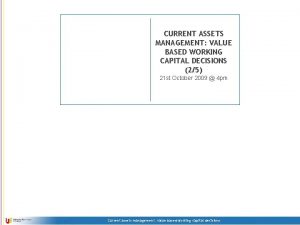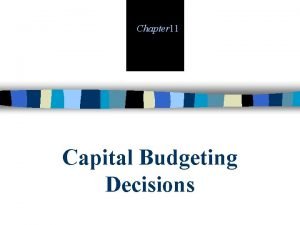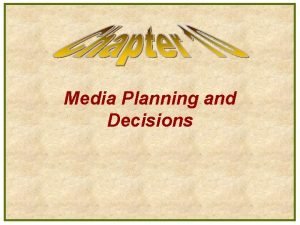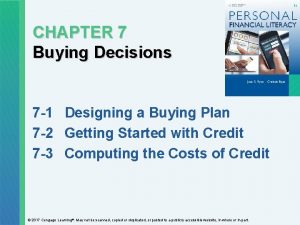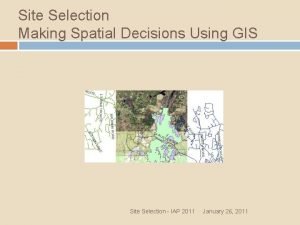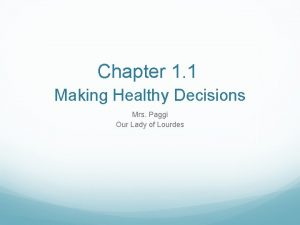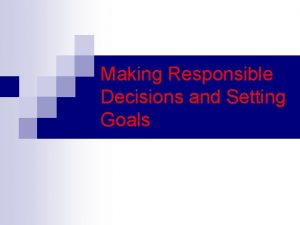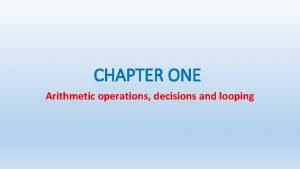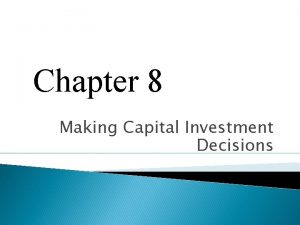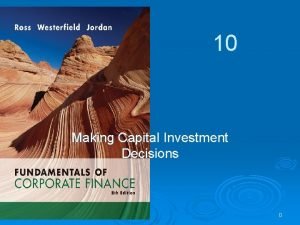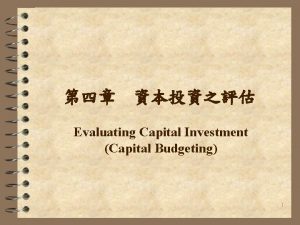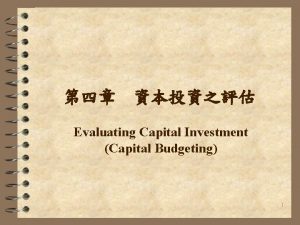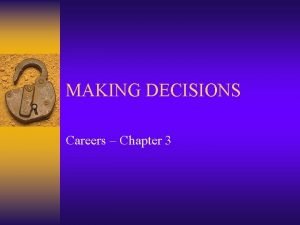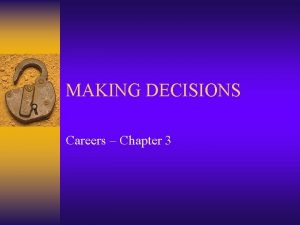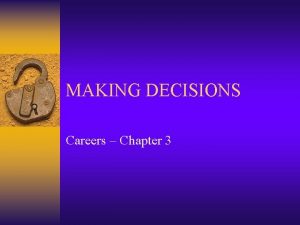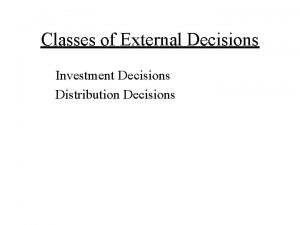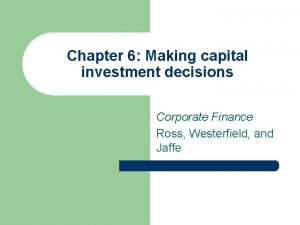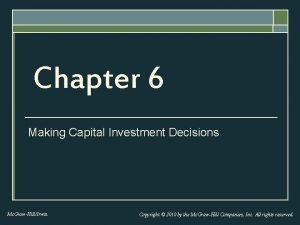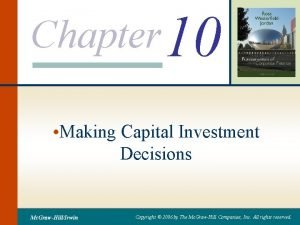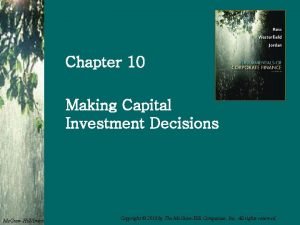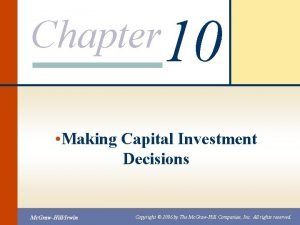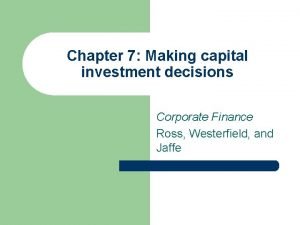Chapter 6 Making Capital Investment Decisions Key Concepts

























- Slides: 25

Chapter 6 Making Capital Investment Decisions

Key Concepts and Skills Understand how to determine the relevant cash flows for various types of capital investments Be able to compute depreciation expense for tax purposes Understand the various methods for computing operating cash flow Evaluate special cases of discounted cash flow analysis Incorporate inflation into capital budgeting 6 -1

Chapter Outline Incremental Cash Flow Alternative Definitions of Operating Cash Flow Some Special Cases of Discounted Cash Flow Analysis Inflation and Capital Budgeting 6 -2

Incremental Cash Flows Cash flows matter—not accounting earnings. Sunk costs do not matter. Incremental cash flows matter. Opportunity costs matter. Side effects like cannibalism and erosion matter. Taxes matter: we want incremental after-tax cash flows. Inflation matters. 6 -3

Cash Flows—Not Accounting Income Consider depreciation expense. ◦ You never write a check made out to “depreciation. ” Much of the work in evaluating a project lies in taking accounting numbers and generating cash flows. 6 -4

Incremental Cash Flows Sunk costs are not relevant ◦ Just because “we have come this far” does not mean that we should continue to throw good money after bad. Opportunity costs do matter. Just because a project has a positive NPV, that does not mean that it should also have automatic acceptance. Specifically, if another project with a higher NPV would have to be passed up, then we should not proceed. 6 -5

Incremental Cash Flows Side effects matter. ◦ Erosion is a “bad” thing. If our new product causes existing customers to demand less of our current products, we need to recognize that. ◦ If, however, synergies result that create increased demand of existing products, we also need to recognize that. 6 -6

Estimating Cash Flows Cash Flow from Operations ◦ Recall that: OCF = EBIT – Taxes + Depreciation Net Capital Spending ◦ Do not forget salvage value (after tax, of course). Changes in Net Working Capital ◦ Recall that when the project winds down, we enjoy a return of net working capital. 6 -7

Interest Expense Later chapters will deal with the impact that the amount of debt that a firm has in its capital structure has on firm value. For now, it is enough to assume that the firm’s level of debt (and, hence, interest expense) is independent of the project at hand. 6 -8

Example 1) The Baldwin Company Costs of test marketing (already spent): $250, 000 q q Current market value of proposed factory site (which we own): $150, 000 q Market value at the end of the year is $30, 000 Production (in units) by year during 5 -year life of the machine: 5, 000, 8, 000, 12, 000, 10, 000, 6, 000 q q q Cost of bowling ball machine: $100, 000 (depreciated according to MACRS 5 -year) q q Price during first year is $20; price increases 2% per year thereafter. Production costs during first year are $10 per unit and increase 10% per year thereafter. Increase in net working capital: $10, 000 q Changes with sales. q Recovered at the end of the project q q Tax Rate=34% Discount Rate=10% 6 -9

Example 2) PUTZ You have been hired as a consultant for Pristine Urban-tech Zither, Inc. (PUTZ), manufacturers of zithers. The market for zithers is growing quickly. The company bought some land three years ago for $1. 4 million in anticipation of using it as a toxic waste dump site but has recently hired another company to handle all toxic materials. ◦ Based on a recent appraisal, the company believes it could sell the land for $1. 5 million on an after-tax basis. ◦ In four years, the land could be sold for $1. 6 million after taxes. 6 -10

Example 2) PUTZ The company also hired a marketing firm to analyze the zither market, at a cost of $125, 000. An excerpt of the marketing reports is as follows: ◦ The zither industry will have a rapid expansion in the next four years. With the brand name recognition that PUTZ bring to bear, we feel that the company will be able to sell 3, 200, 4, 300, 3, 900, and 2, 800 units each year for the next four years, respectively. ◦ Again, capitalizing on the name recognition of PUTZ, we feel that a premium price of $780 can be charged for each zither. ◦ Because zithers appear to be a fad, we feel at the end of the four-year period, sales should be discontinued. 6 -11

Example 2) PUTZ believes that fixed costs for the project will be $425, 000 per year, and variable costs are 15% of sales. The equipment necessary for production will cost $4. 2 million and will be depreciated according to three year MACRS schedule. ◦ At the end of the project, the equipment can be scrapped for $400, 000. Net working capital of $125, 000 will be required immediately. ◦ Net Working Capital is recovered at the end of the project. PUTZ has a 38% tax rate, and the required return on the project is 13%. What is the NPV of the project? Assume the company has other profitable projects. 6 -12

Some Special Cases of Discounted Cash Flow Analysis Cost-Cutting Proposals Investments of Unequal Lives 6 -13

Cost-Cutting Proposals Cost savings will increase pretax income ◦ But, we have to pay taxes on this amount Depreciation will reduce our tax liability Does the present value of the cash flow associated with the cost savings exceed the cost? ◦ If yes, then proceed. 6 -14

Example of Cost Cutting Proposal We are considering automating some part of an existing production process. The necessary equipment costs $80, 000. The automation will save $22, 000 (before taxes). The equipment has 5 year life and is depreciated straight-line to zero over five years. The machine will be worth $20, 000 in five years. Should we automate? Discount rate is 10% Relevant cash flows ◦ Cost of the machine ($80, 000) ◦ After-tax salvage value (20, 000 x (1 -0. 34) = $13, 200) ◦ Additional depreciation deduction 6 -15

Example of Cost Cutting • Operating Cash Flow = EBIT – Taxes + Depreciation EBIT= Sales- Costs-Depreciation EBIT = $22, 000 – $16, 000 = $6, 000 Taxes = EBIT x Tax rate = $6, 000 x 0. 34 = $2, 040 OCF = $6, 000 - $2, 040 + $16, 000 = $19, 960 Cost savings increase our pretax income by $22, 000. We have to pay taxes on this amount , so our tax bill also increases. 6 -16

Investments of Unequal Lives There are times when application of the NPV rule can lead to the wrong decision. Consider a factory that must have an air cleaner that is mandated by law. There are two choices: ◦ The “Cadillac cleaner” costs $4, 000 today, has annual operating costs of $100, and lasts 10 years. ◦ The “Cheapskate cleaner” costs $1, 000 today, has annual operating costs of $500, and lasts 5 years. Assuming a 10% discount rate, which one should we choose? 6 -17

Investments of Unequal Lives Cadillac Air Cleaner CF 0 – 4, 000 Cheapskate Air Cleaner CF 0 – 1, 000 CF 1 – 100 CF 1 – 500 F 1 10 F 1 5 I 10 NPV – 4, 614. 46 NPV – 2, 895. 39 At first glance, the Cheapskate cleaner has a higher NPV. 6 -18

Investments of Unequal Lives This overlooks the fact that the Cadillac cleaner lasts twice as long. When we incorporate the difference in lives, the Cadillac cleaner is actually cheaper (i. e. , has a higher NPV). 6 -19

Equivalent Annual Cost (EAC) The EAC is the value of the level payment annuity that has the same PV as our original set of cash flows. ◦ For example, the EAC for the Cadillac air cleaner is $750. 98. ◦ The EAC for the Cheapskate air cleaner is $763. 80, thus we should reject it. 6 -20

Cadillac EAC with a Calculator N 10 – 100 I/Y 10 F 1 10 PV – 4, 614. 46 I 10 PMT 750. 98 CF 0 – 4, 000 CF 1 NPV – 4, 614. 46 FV 6 -21

Cheapskate EAC with a Calculator N 5 – 500 I/Y 10 F 1 5 PV -2, 895. 39 I 10 PMT 763. 80 CF 0 – 1, 000 CF 1 NPV – 2, 895. 39 FV 6 -22

Inflation and Capital Budgeting Inflation is an important fact of economic life and must be considered in capital budgeting. Consider the relationship between interest rates and inflation, often referred to as the Fisher equation: (1 + Nominal Rate) = (1 + Real Rate) × (1 + Inflation Rate) 6 -23

Inflation and Capital Budgeting For low rates of inflation, this is often approximated: Real Rate Nominal Rate – Inflation Rate While the nominal rate in the U. S. has fluctuated with inflation, the real rate has generally exhibited far less variance than the nominal rate. In capital budgeting, one must compare real cash flows discounted at real rates or nominal cash flows discounted at nominal rates. 6 -24
 Interest tax shield formula
Interest tax shield formula Chapter 10 making capital investment decisions
Chapter 10 making capital investment decisions Making capital investment decisions
Making capital investment decisions Nwc change
Nwc change Making capital investment decisions
Making capital investment decisions Poster making meaning
Poster making meaning Screening decisions and preference decisions
Screening decisions and preference decisions Corporate financing and investment decisions
Corporate financing and investment decisions Explain the fundamental concepts of managerial economics
Explain the fundamental concepts of managerial economics Chapter 1 economic decisions and systems answer key
Chapter 1 economic decisions and systems answer key Fixed investment and inventory investment
Fixed investment and inventory investment Depreciation tax shield in capital budgeting
Depreciation tax shield in capital budgeting Advantages of capital budgeting
Advantages of capital budgeting Capital budgeting decisions ppt
Capital budgeting decisions ppt Operating cycle method
Operating cycle method Initial outlay
Initial outlay Working capital decisions
Working capital decisions Capital budgeting decisions include
Capital budgeting decisions include Nature of capital budgeting decisions
Nature of capital budgeting decisions Gross rating points
Gross rating points An organized method for making good buying decisions.
An organized method for making good buying decisions. Chapter 7 buying decisions
Chapter 7 buying decisions Making spatial decisions using gis
Making spatial decisions using gis Making healthy decisions unit test
Making healthy decisions unit test Making responsible decisions and setting goals
Making responsible decisions and setting goals How would you use arithmetic sequence in making decisions
How would you use arithmetic sequence in making decisions
